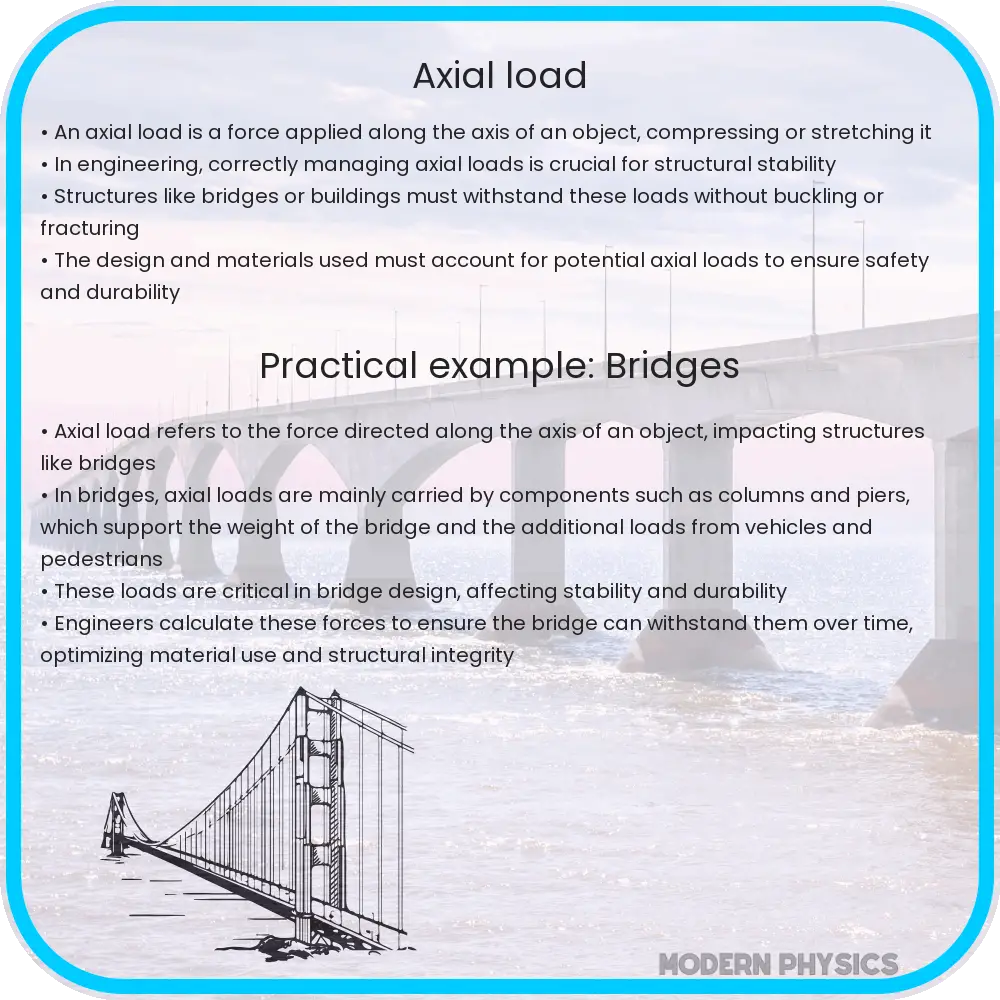Explore axial load in engineering: Understand its impact on strength, stress analysis, and stability with advanced concepts and practical applications.

Axial Load: Understanding Its Impact in Engineering
Axial load is a critical concept in the field of engineering, particularly in structural, mechanical, and civil engineering. It refers to the force applied along the axis of an object, affecting its strength, stress distribution, and overall stability. This article delves into the fundamental aspects of axial loads, their impact on structures and materials, and the principles of stress analysis associated with them.
What is Axial Load?
An axial load is a force that is applied along the longitudinal axis of a structural element. This type of load can be either tensile (pulling force) or compressive (pushing force). The primary characteristic of an axial load is that it is typically uniform over the cross-section of the element it is applied to. Common examples include the weight of a column pressing downwards due to gravity or the tension in a cable caused by a hanging load.
Strength and Stress Analysis under Axial Load
The strength of a material or component under axial load is determined by its ability to resist deformation and failure. Two key factors in this analysis are the material’s yield strength and ultimate strength. Yield strength is the stress at which a material begins to deform plastically, while ultimate strength is the maximum stress a material can withstand before failure.
- Stress-Strain Relationship: The behavior of materials under axial loads can be understood through the stress-strain curve, which plots the stress (σ) against the strain (ε). Stress is defined as the force (F) per unit area (A), given by σ = F/A, and strain is the deformation experienced by the material relative to its original length.
- Elastic and Plastic Deformation: In the elastic region, materials return to their original shape after the load is removed. Beyond the yield point, materials enter the plastic region, where permanent deformation occurs.
Stability Analysis
Stability analysis under axial load is crucial, especially for columns and beams. The Euler Buckling Formula, given by \( P_{cr} = \frac{\pi^2 E I}{(KL)^2} \), where \( P_{cr} \) is the critical buckling load, E is the modulus of elasticity, I is the moment of inertia, K is the column effective length factor, and L is the actual length of the column, helps in determining the buckling load. This formula is vital for ensuring that structures can withstand axial loads without collapsing.
In summary, understanding the effects of axial loads on materials and structures is essential for ensuring their strength, stability, and longevity. The next section will explore practical applications, case studies, and advanced concepts in the context of axial load analysis.
Advanced Concepts in Axial Load Analysis
Delving deeper into axial load analysis, engineers often encounter complex scenarios where advanced concepts and calculations become necessary. This includes the consideration of factors such as material anisotropy, temperature effects, and dynamic loading conditions.
Material Anisotropy and Axial Loads
Many materials used in engineering, like composites and certain metals, exhibit anisotropic behavior, meaning their properties vary with direction. In such cases, the axial load analysis must account for different strength and stiffness characteristics along different axes. This complexity is handled through advanced material models and computational methods.
Temperature Effects on Axial Load Bearing
Temperature can significantly impact the behavior of materials under axial loads. High temperatures may reduce the yield and ultimate strength, leading to earlier onset of plastic deformation or failure. Conversely, in some materials, low temperatures can increase brittleness. Engineers must factor in these temperature-dependent properties for accurate stress analysis, especially in environments with extreme temperature variations.
Dynamic Axial Loading Conditions
Unlike static loads, dynamic loads (such as those experienced in machinery or during earthquakes) vary over time. This introduces additional challenges in axial load analysis, such as the assessment of fatigue life under cyclic loading and the potential for resonance in structural elements. Dynamic analysis often involves complex calculations and simulations to predict how materials and structures will respond to such varying loads.
Practical Applications and Case Studies
Practical applications of axial load analysis are vast, ranging from the design of high-rise buildings and bridges to the engineering of aerospace components and machinery. Case studies often reveal the importance of accurate axial load analysis in preventing structural failures. For example, the analysis of bridge cables under varying traffic loads or the assessment of pressure vessels in industrial settings are crucial for ensuring safety and reliability.
Conclusion
Understanding axial load is fundamental in the realm of engineering, affecting the design, safety, and functionality of various structures and components. From basic principles like stress-strain relationships to more complex considerations such as material anisotropy and dynamic loading, axial load analysis is a multifaceted field. The integration of theoretical knowledge with practical applications, supported by advanced computational tools, ensures the resilience and longevity of engineering designs. As technology advances, the field of axial load analysis will continue to evolve, offering even more precise and efficient ways to address the challenges of modern engineering.
